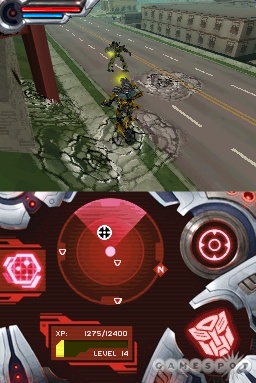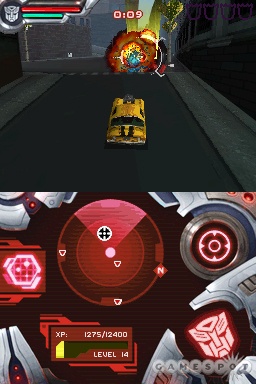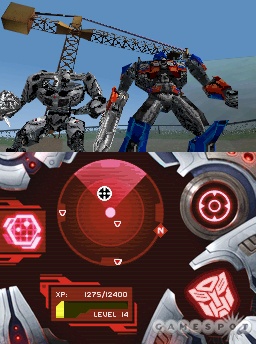Transformers: Autobots and Transformers: Decepticons are two sides of the same coin. Both games tell the same general story, they both share the same environments, and they both let you run amok as a robot that can transform into various vehicles. The main thing distinguishing the two versions is that you fight as a heroic Autobot in one and an evil Decepticon in the other. Regardless of which version you choose to bring home, you'll probably get a kick out of beating up opposing robots and exploring the huge 3D environments incognito as a car, helicopter, or some other Earthly conveyance. The bad news is that the uninspiring story missions and brief overall length pretty much guarantee you'll be done with the game for good in six hours or less.

When you first start the game, you'll watch a short video clip narrated by either Optimus Prime or Starscream (depending on the version) that explains how Megatron, the Decepticon leader, came to Earth 100 years ago searching for something called the "Allspark," and how both the Autobots and Decepticons have come to Earth to reclaim the mysterious artifact. Key events from the recent movie are depicted, but the human point of view is notably absent. On the Autobots' side, you take orders from Optimus Prime and go out on missions that involve gathering information, escorting human vehicles, or stopping Decepticon raids. On the Decepticons' side, you'll answer to Starscream and your missions will mainly involve causing public destruction and stealing from fortified military bases. Both games share three locations in common and have one exclusive location. In the Autobots version, you'll shadow the military's recovery of Megatron from the Arctic. In the Decepticons version, you'll take part in the Decepticon assault in Qatar. Also, each version has its own, unique ending.
A good way to describe the game is that it's Grand Theft Auto with giant robots instead of mobsters. As the story unfolds, you'll find yourself in large 3D environments complete with streets, buildings, traffic lights, and innocent car traffic. You can go anywhere you like on foot or in vehicle form, and you're free to climb up buildings, smash light poles, and throw cars around. In your vehicle form, nobody will take notice of you. However, if you roam around on foot or cause enough damage, robots from the other side as well as military vehicles will take notice of you and attack with lasers and armor-piercing bullets. You can fight back with your robotic fists or dish out the pain from a distance with your own lasers and missiles. Reducing rival robots to rubble is satisfying, but the combat is also very shallow. You have a few melee and weapon attacks, you can move out of the way of oncoming fire, and you can jump--that's it. There aren't any power-up items to speak of either, apart from the health-recovery orbs that exploding objects and robots occasionally leave behind. CPU-controlled enemies also do a lousy job of avoiding your attacks, although they generally have twice as much armor as you do. When you get bored of fighting, you can transform into your vehicle form and hide until the alert level goes back to normal.
Scattered throughout each environment are a number of spots that you can visit in order to attempt various challenge and story-related missions. Challenge missions involve simple tasks such as destroying cars or racing from one place to another. You can replay challenge missions as often as you like. By contrast, story missions are doled out in a set order and involve multi-step tasks that occasionally let you control familiar Transformers. In the Autobots version, you'll have opportunities to take Bumblebee, Optimus Prime, Ironhide, Jazz, and Ratchet for a spin. In the Decepticons edition, you'll have brief stints with Barricade, Brawl, Blackout, Starscream, and Megatron. For the majority of missions, though, you'll control your generic create-a-bot. Being a create-a-bot has its perks. First, while the namesake bots have preordained rankings for strength and firepower, your generic bot's rankings continually grow as you gain experience from completing missions. Secondly, your custom bot isn't limited to a single transformation like the others are. You start out with a "beater" body, but you can gain new transformations by scanning the vehicles you come across on your travels. Your create-a-bot can transform into as many as 37 different cars, trucks, helicopters, and airplanes. Some skins even resemble popular characters from the Generation One cartoon and toy line.
The game's biggest problem is that the majority of mission designs lack creativity and fail to include familiar Transformers characters. Out of 30 story missions, roughly one-third bring transformations into play or involve a dramatic battle against a key foe. The rest simply involve traveling from one place to another or destroying a certain number of objects before time runs out, while the majority of enemies are military vehicles and generic no-name robots. Doing the same boring missions all the time gets old rather quickly. The thrill of exploring the world as a Transformer also wears off eventually. At some point after an hour or two, you'll find yourself going through the motions only because you want to see how the story ends. As it is, the story mode barely takes four hours to finish.
All of the robots look nice up close, and their face and body details are generally well-defined. Transformations happen in a few quick steps and are totally sweet. The streets and buildings in the surrounding environment look simple by comparison and occasionally suffer from blocky or missing textures, but the sheer number of objects being displayed at any given time by the game's 3D engine is still impressive. The draw-in distance could be better, and fog conveniently makes it tougher to notice buildings popping into view, but you can always see a large portion of the world around you and any robots or tanks that happen to be nearby. While you can't actually destroy entire buildings, you can at least blacken them with your weapons. You can also smash surrounding fixtures like streetlights and dumpsters, and leave cracks in the pavement by jumping.

The audio mainly consists of a decent assortment of weapon and explosive noises, along with some hilarious radio chatter comments from nearby police and military vehicles. Robots that attack you will occasionally voice a taunt as well, and their laser blasts sometimes make the "ch-ch-choo" sound that the lasers made in the 1980s cartoon series. Story scenes put together with in-game graphics and recorded voice dialogue frequently appear, but what's really impressive is just how much recorded dialogue the developers managed to cram into a DS cartridge. Every story scene has at least a few lines of conversational dialogue, and each version of the game probably has around 30 unique story scenes. Activision wisely enlisted Peter Cullen and Frank Welker to lend their voices to "Optimus Prime" and "Megatron," respectively, just as they did in the cartoons. Steve Blum and Keith David do a great job voicing the generic bot and "Barricade" respectively. Transformers: Autobots and Transformers: Decepticons set a new standard for both the amount of and the quality of voice acting in a DS game.
For the most part, both versions of the game provide the same experience. Each version has five robot skins that the other doesn't, but the underlying transformations are identical in both games. You'll attempt a couple more stealth and escort related missions in the Autobots version, while the Decepticons version has a few more rampage missions. However, the bulk of missions in both games are structured similarly. The only upside that one version has over the other is that it's easier to gain experience and build strength in the Decepticons' game, because they gain experience from destroying property and police vehicles. The goodie-goodie Autobots are supposed to protect humanity, so they only earn experience by trashing Decepticons and completing missions.
Whichever side you play, you will have to develop a certain tolerance for the targeting cursor and camera position. The targeting cursor will sometimes lose hold during the heat of battle, and the camera will often do a 180 if you take damage, which leads to numerous missed shots and plenty of time spent holding the shoulder button to move the camera back where you want it. Most of your deaths and mission failures won't be caused by your own lack of skill, but because the cursor and camera make it tough to keep track of your enemies. Thankfully, your character's health grows with every level upgrade, so deaths caused by the camera, and just deaths in general, happen less frequently the longer you play.

In addition to the main story mode, the game also offers a multiplayer battle mode and a unique, online score-attack mode. The multiplayer battle mode is nothing special. Four people pick their bots and duke it out in deathmatch or keep-away matches. The score-attack mode, on the other hand, is actually rather interesting. Each day, you log into a server and download a new challenge mission. These missions are timed and typically involve destroying property or catching air off of jump ramps. For the rest of the day, you play the mission as often as you like and build up a score. Then, at the end of the day, you log back in and your score will be uploaded. The interesting aspect is that people playing the Autobots version of the game are all on one side, while everyone that bought the Decepticons version is on the other. The scores on both sides are added together and the side with the highest score is declared the winner for that day. At the end of the week, the team with the most daily wins gains possession of the "Allspark." Based on how significant your contribution is, you'll receive in-game tokens each day that eventually unlock the vehicle skins that aren't present in the main story mode.
As you can see, the differences between the two versions of the game are mostly cosmetic. Some people will enjoy the Decepticons version more because you gain experience faster and don't have to complete as many stealth missions, although that's really a matter of personal taste. In either case, the games look nice, the voice acting is marvelous, and transforming into vehicles and beating up on other robots is fun. It's just too bad Activision chose to publish two individual versions instead of a single game. The dodgy camera and targeting may be annoying, but all the filler missions and the overall short length of the story suck a lot of the joy out of being a Transformer.